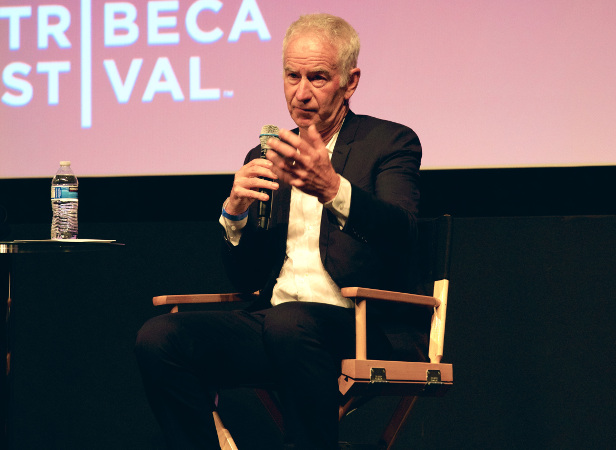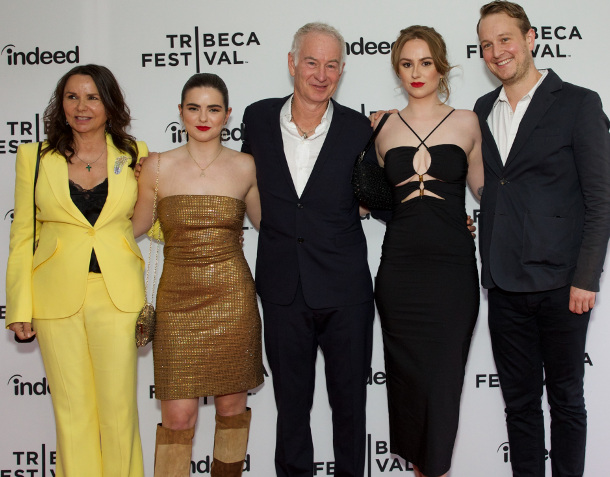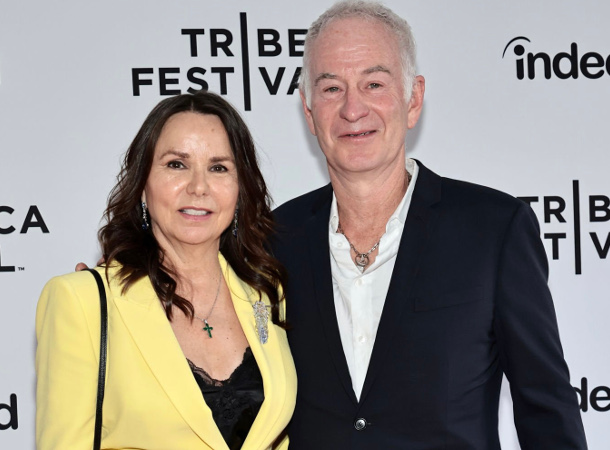By Richard Pagliaro | Friday, June 17, 2022
John McEnroe opens up on the magic and madness of his life and career in the new Showtime sports documentary McEnroe.
Photo credits for all images: Showtime
The shadow casts instructive light across the fallen star.
In one of the most striking tennis scenes—and there are many—in the new Showtime sports documentary McEnroe, John McEnroe goes airborne lunging for a ballistic Ivan Lendl passing shot during the 1984 Roland Garros final.
The blurring ball eludes a sprawling McEnroe leaving the left-hander tasting dirt, wearing an empty expression and a swath of salmon-colored clay streaking his white clothes.
Rising to his feet, McEnroe gazes back at the spot where he crashed on clay and realizes an out almost out of body experience seeing himself still down. Like a corpse springing from a chalk outline at a crime scene, McEnroe observes his own demise between the lines bluntly.
“I was done,” McEnroe says.
Indeed, McEnroe squandered a two-set lead and saw his Roland Garros dream dissolve to Lendl in one of the most gut-wrenching losses of his life.
The scene sums up McEnroe’s presence in a revealing new documentary: he hurls himself into the stormy and celebratory moments of his life and career and shares lessons learned with the candor that comes from age and experience.
Thirty-eight years after his painful Paris collapse, McEnroe is sitting on the stage of the SVA Theater on 23rd street in New York City revealing he’s still so haunted by that five-set loss to Lendl he suffered a sleepless night dwelling on it during his trip to Paris to cover Roland Garros for NBC weeks earlier.
The mercurial McEnroe faces his fears, demons, his dad and toughest opponent of all—his shadow self—in a fascinating new documentary from director/writer Barney Douglas.
The one hour, 44-minute documentary debuted to a vocal, enthusiastic and positive response from a packed audience at the Tribeca Film Festival in New York City on Friday, June 10th.
McEnroe will be available Friday, September 2nd on all streaming and on demand platforms for Showtime subscribers, before making its on-air debut on Sunday, September 4th at 8 p.m. on Showtime. The film will release theatrically in the U.K. on Friday, July 15th.
The gritty McEnroe takes viewers inside the mind of one of tennis’ most controversial and combustible champions as he stalks the streets of New York City over the course of a single night, retracing his life and reflecting on triumph and loss in previously unseen archival footage.
From his upbringing in Douglaston, N.Y., to the Port Washington Academy courts where he honed his skills to a Wimbledon semifinals run as an 18-year-old qualifier, to his sole year at Stanford University winning the NCAA Men’s Tennis Championships and his Hall of Fame professional career where he captured seven Grand Slam singles titles, the documentary covers everything inside and outside the lines and takes a deep dive inside McEnroe’s mind.
The documentary packs the good, bad and ugly of the Queens native who combined sculptor’s feel and surgeon’s precision with sniper’s thrill for the kill producing one of the greatest single seasons in tennis history. In 1984, McEnroe delivered a mind-blowing 82-3 season capturing 13 titles, including Wimbledon and the US Open. The late,, greater writer Frank DeFord called it one of the most dominant single seasons he’d ever seen from any athlete in any sport.
At the very peak of his powers, McEnroe admits operating in rare air felt like a tennis trap.
“Greatness is a combination of things,” McEnroe says as the film opens. “You look back and you say, ‘Well, someone gave me an ability to do something better than others.’ You have to recognize that and put yourself on the line. Especially when you’re out there by yourself.
"And I didn’t do a good enough job of that. In fact, I did a shitty job of it. I’m the greatest player who’s ever played the game, at this point [1984]. Why does it not feel that amazing? I felt like I was doomed.”
Visually, the film does a fine job of utilizing the streets of New York City as a forceful character in McEnroe’s development. The documentary plays on the iconic image of McEnroe, looking like a young James Dean walking alone through a deserted Times Square, that was the cover of his memoir You Cannot Be Serious by placing him back in New York City streets emerging from shadows of buildings to tell his story as he walks.
It's an effective device showing McEnroe weaving his way through the streets of New York with the same savvy he showed carving out audacious angles working inside the rectangular box that is a tennis court. The documentary suggests the electric energy, intensity and smooth movement McEnroe brought to the court was partly inspired by life navigating the New York Streets. If the New York is a melting pot, McEnroe was a pressure cooker of intensity and over-stimulated tennis prodigy bound to burst.
Bjorn Borg, Billie Jean King, Chrissie Evert, Peter Fleming, McEnroe’s doubles partner, and some surprise champions are among the players voicing their views in the documentary.
“True artists make you feel,” Hall of Famer and McEnroe friend Billie Jean King says. “John McEnroe made you feel every time he played.”
Indeed, it’s been 41 years since McEnroe beat rival Bjorn Borg to capture his maiden Wimbledon crown in 1981. Borg is both an emotional counter-point and voice of reason in the film.
Though McEnroe claims off court he and Borg are much more alike than people realize, we see each element of the fire and ice rivalry live in completely different comfort zones.
A relaxed Borg recalls the glory days of a fire and ice rivalry that spanned exactly 14 matches as he sits in the backyard of a simple home beside a Swedish lake finding the peace he longed for during his playing days. Meanwhile, a brooding McEnroe stalks the New York City streets from Queens to Chinatown to an empty Arthur Ashe stadium appearing as both audience and athlete and alternating between an ease and unease trying to make sense of it all.
So why does McEnroe still resonate and make so many fans feel so deeply decades later?
One of the most polarizing players in tennis history is an ideal subject for the divided times we live in these days because McEnroe forces you to take sides. There is no indifference to John McEnroe even in his native New York, as his wife, Patty Smyth, points out in the film: you either love him or hate him.
McEnroe wasn’t the first champion to trash talk on a tennis court, but he was one of the fiercest competitors. Along with other legendary American champions—Pancho Gonzalez, Jimmy Connors and Serena Williams to name a few—McEnroe was among the best ever producing sublime points after major meltdowns. The director suggests McEnroe was the tennis equivalent of A Beautiful Mind, a math whiz who could calculate all of his available shot options and his process his opponent’s potential responses like a super computer all while moving forward executing his attacking game. While McEnroe was often portrayed as a risk-taking serve-and-volley daredevil, the truth is at his best he was the ultimate percentage player. McEnroe understand displacing opponents with his can-opener serve created a vast expanse of open court. He was at his best rushing forward, stealing time from his opponent with abbreviated backswings and the fearless feel of a pickpocket.
Beyond tennis, the documentary reminds us McEnroe served and volleyed his way into American pop culture—and has never really left the frontcourt. McEnroe helped establish Nike as a top tennis brand, with the Swoosh sneaker maker emblazoning his face on Manhattan billboards and buildings. The Hall of Famer hung out with artists, actors and rock stars—the Pretenders’ Chrissie Hynde and Keith Richards of the Rolling Stones both lend their perspectives in this documentary—and famously posed with first wife Tatum O’Neal for an Andy Warhol painting, which his son reveals he once defaced in anger at his parents arguing by scrawling a mustache on Warhol’s image of his famous father’s face.
One of a handful of champions to hold world No. 1 rankings in singles and doubles simultaneously, McEnroe has built a lucrative post-playing career in part because he’s not scared to try new things. McEnroe has been a successful art collector, a New York Times best-selling author, a TV talk show host, a TV game-show host, a comic actor poking fun at his angry persona in an Adam Sandler film, the narrator and voice of angst in the Mindy Kaling-produced Never Have I Ever Netflix show, a long-time award-winning tennis television analyst and a coach and mentor to kids who attend his John McEnroe Tennis Academy on Randall’s Island in New York City.
Perhaps a bigger reason for his longevity is because in his post-tennis career McEnroe has been able to express exactly what he could never do on court: laugh at his own temperamental transgressions. Tennis’ former raging rebel has become a white-haired voice of reason in part because he sees and illuminates the shades of gray in a sport he once viewed solely in black and white.
As McEnroe once told me in an interview during his playing days: "When I turned pro out of Stanford I told myself I had two choices: Win or win. I didn't to fail."
The figure we see striding the darkened city streets tries to come to grips with the cost of a winning-at-all-costs mentality and the emotional price you pay when you realize you're no longer the best in the world and never will be again.

Ultimately, the documentary asks what drove McEnroe to such imaginative heights and insane depths on court—sometimes in the space of a few games—and questions could he have created the magic without the madness?
The intensity was the fuel that burned McEnroe's competitive fire, but it ultimately consumed him. McEnroe was 25 years old when he won the 1984 US Open; he never captured another singles major. Coming to terms with the fact he never recaptured his most dynamic tennis on the singles court again is a harsh reality for a brash champion.
"When I took time off and came back, I truly believed I would come back better than I was," McEnroe told Tennis Now. "Because it was tortuous to play the last few years of my career knowing in a way I wasn’t going to win. I kept playing but it was way more of a long shot than I wanted to admit.
"And I’m like how the hell did it get to this? When I originally took time off in ’86 I felt like I was gonna come back better than I was not worse. So that part was extremely frustrating. I feel like I don’t dwell on things too long, but perhaps sometimes I do."
Throughout the documentary, McEnroe offers various explanations for his volatility, including he learned from Jimmy Connors, Ilie Nastase and good buddy Vitas Gerulaitis “you have to be a lunatic out there.” The win-at-all-costs mentality instilled by his father, an Air Force veteran who worked three jobs to put himself through Fordham law school graduating second in his class, which prompted his wife to ask why he wasn’t first.
Clearly, McEnroe is wired differently from you and me and even conventional champions prompting his wife, Patty, to wonder at one point if he's "on the spectrum."
In this documentary, we hear McEnroe’s voice wry, rueful and painful at times.
Personal moments are often the most poignant and powerful.
During the break-up of his marriage to actress Tatum O'Neal, McEnroe tries to defend his parenting telling his young son "At least I show up, I'm consistent." To which his son shoots back: "Yeah, a consistent asshole!" sharing the shattered look on his father's face as a moment of deep regret he's never forgotten.
McEnroe reveals he decided to fire his father as his manager because he wanted him to be a dad and not talk “tennis, tennis, tennis” every time they got together. Though John McEnroe Jr, hoped splitting business ties with his dad would bring them closer together as father and son, sadly the film shows the decision had the opposite impact on their relationship.
In a powerful scene shot near the end of his life that illustrates rift between father and son, the elder McEnroe is introduced as "John McEnroe, Sr." during a video interview, which prompts him to stop the interview and correct the record. "I'm not John McEnroe, Sr. I'm John McEnroe. He's John McEnroe, Jr." he says of his famous son.
The decline of his father, who waged on an ongoing battle with alcohol in his later years, and its collateral damage on his family and his conscience clearly still deeply pains McEnroe, who told us reliving part of his life that was one of the toughest parts of this project. In tennis and in life, sometimes there aren't happy endings.
“Probably what was going on with my father for a period of time culminating in an empty ending in a way which is tough was one of the most painful parts,” McEnroe told us.
“But I’m not the first guy to lose their father. You know my wife Patty’s father died when she was 7. And I was 57 or 58 so I’ve got to consider myself fortunate but just rehashing that is difficult.”
McEnroe owns up to vices in the documentary—his volatile temper, unrelenting quest for perfection and a sex, drugs and rock n’ roll lifestyle that saw him using alcohol, cocaine and marijuana to excess at times in his younger years. The film touches on his tempestuous first marriage to actress Tatum O’Neal and the couple’s struggles with various addictions.
In an on-stage Q&A after the film’s premiere, McEnroe joked “Nowadays, some players use Performance Enhancing Drugs. In my day, we did Performance Diminishing Drugs.”
At one point in the documentary, McEnroe is asked to detail his definition of love. He stumbles for an answer.
By the final frames of the film it’s clear that family is the answer for him.
The man who thrived as a solo artist has found love and support in the family team. McEnroe and wife Patty have been together nearly 25 years, he credits his wife for saving his sanity after he called her for support late at night after learning of the sudden death of buddy Vitas Gerulaitis. McEnroe seems to enjoy a strong relationship with his kids, who were at the premiere, and works with brothers Mark McEnroe and Patrick McEnroe at the John McEnroe Tennis Academy on Randall’s Island.
Patty Smyth, who McEnroe confides "calls the shots in the family", delivers one of the best lines in the film summing up her husband's evolution: "I married a bad boy who became a good man."

The late, great John Lennon, another famous New Yorker who lived on Central Park as McEnroe does, famously said in one of his final interviews with writer David Sheff “I don’t believe in yesterday. I am only interested in what I am doing now.”
Similarly, we heard McEnroe say several times both before and after the documentary’s premiere “I don’t like to look back.”
Yet with both his memoir You Cannot Be Serious and McEnroe the documentary, McEnroe not only revisits the past with nuance he’s often perceptive sharing how looking back has shaped him now.

It’s a reach to say McEnroe has found his serenity now—he’s still the jittery, angst-ridden and sometimes manic personality fans know—but seeing joy on his face hanging with his family on the red carpet he does seem at peace with his past.
Still, it’s a step in the right direction for a man who played his best always moving forward.
Seeing his life story on screen, McEnroe told us the biggest epiphany is gratitude to be a survivor still in the game.
“I think that’s the most gratifying part for me that I am still here,” McEnroe told Tennis Now. “Looking back in that one moment in ’84 and ’85 I was like you know I’m the best tennis player that ever was in a way.
“But there’s something missing in my life. I’m not saying the way I ended up going about it or expressing it was the answer. But I knew something was missing in a way and I think it humbled me—I ate some humble pie when I came back in ’86 and I never won another singles Slam—but I’m happy because I think it made me a better person."
At the premiere, McEnroe wasn’t scowling at the ghosts of the pasts alive on the screen and sometimes haunting his head, he was smiling at the shadows and his place among them.
“I feel I turned lemons into lemonade in a way—in my view anyway." McEnroe said.